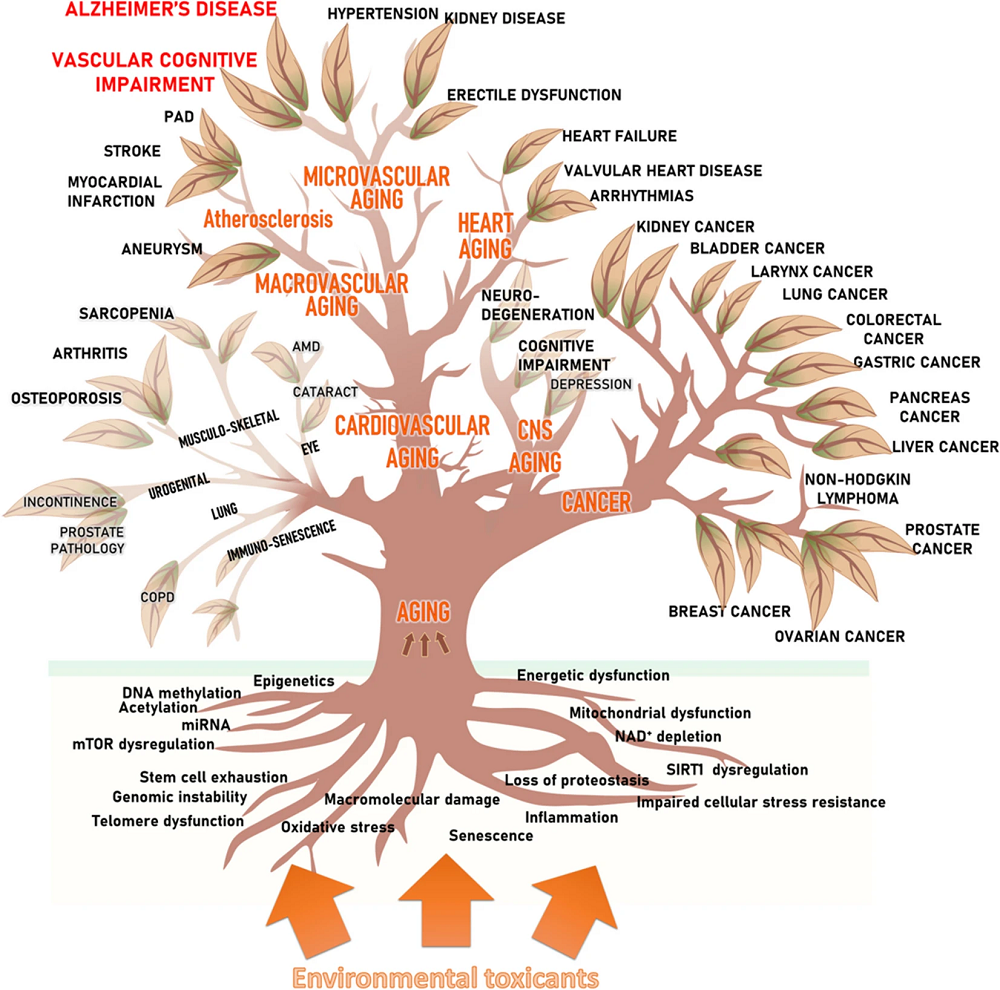A review paper published in GeroScience has detailed a substantial amount of research into the ways that environmental pollutants accelerate aging.
A new model for an old problem
This paper begins with the well-known fact that age-related diseases, defined here as age-related non-communicable diseases (NCDs), are extremely prevalent throughout the Western world. These include such ailments as type 2 diabetes, heart disease, sarcopenia, and neurodegenerative disorders such as Alzheimer’s disease. A full nine-tenths of people over 65 have at least one NCD, with three-quarters of people having two or more.
The researchers then turn to the well-known biological causes of aging, listing the Hallmarks of Aging in detail. They present their own visual model of the relationship between the biological root causes of aging and symptoms, with the addition of environmental stressors that speed up the process.

They refer to these environmental stressors as part of the exposome, the sum total of external factors that influence health [1]. Many of these stressors are pollutants that have been substantively linked to rapid aging in previous research [2]. This review collates that previous research
Cardiovascular diseases
Aging is a major contributor to heart and vascular diseases, and the researchers note that simply being older is a stronger risk factor for these diseases than other well-known contributors, such as leading a sedentary lifestyle. This includes such factors as oxidative stress and reactive oxygen species, which lead to arterial stiffness, mitochondrial dysfunction, and genomic damage [3].
Air pollution is a known contributor to these diseases. The Global Burden of Disease Study 2019 estimated that fine particulate matter contributed to 2.9 million deaths, half of which were related to heart attacks and strokes [4]. One specific chemical, acrolein, comes from the burning of a wide variety of organic substances (including fats), and the EPA has designated it as a high-priority issue due to its documented contributions to atherosclerosis [5].
Smoking is also well-known to cause significant cardiovascular issues, and this review cites research showing that it damages the lining of blood vessels, causes the formation of foam cells within the arterial lining, and accelerates oxidative stress along with the matrix metalloproteinases associated with senescent cells and aging [6]. Secondhand smoke is also known to cause increases in risk.
Water pollution is also a concern for cardiovascular health. Arsenic is a well-known poison, and even at the relatively low doses in pollution, it still contributes to cardiovascular diseases [7]. Mercury, another well-known water pollutant, is also associated with these diseases [8].
Brain, lung, and bone disorders
Many of the pollutants that are related to cardiovascular disorders affect the brain as well, and a substantial portion of this effect is due to damage to blood vessels. These researchers note that problems with the the microvasculature in the brain can make Alzheimer’s disease worse [9]. Lead is one of the most well-known contributors to brain damage, and solvents are reported to contribute to Alzheimer’s as well [10].
As expected, environmental pollutants can contribute to oxidative stress in the brain along with such hallmarks as mitochondrial dysfunction, which have been reported to lead to accelerated brain damage [11]. An increase in oxidative stress is also linked to microglial activation and inflammatory disorders [12].
Chronic obstructive pulmonary disorder (COPD), which contributed to 3.3 million deaths in 2019, is strongly associated with aging, and so the researchers focus on COPD when discussing the effects of air pollution. While this disease is strongly associated with lifelong smoking habits, it is also associated with poor air quality, and the World Health Organization notes that 18% of deaths related to air pollution occur through COPD.
Poor air quality also contributes to bone loss [13], and lead is an occupational hazard that contributes to osteoporosis as well [14]. Cadmium is a less well-known pollutant that also decreases bone density [15].
The damage repair perspective
The number of ways in which air pollutants contribute to age-related diseases is enormous; biology is extraordinarily complicated, and there are a great many environmental chemicals that are known to be toxic. This combinatorial interaction might mean that there are millions or even billions of specific biological ways in which pollutants accelerate aging.
From a perspective that views aging as damage over time, however, the goal is simple and easy to explain: sources of damage, including environmental damage, are to be minimized and avoided whenever possible, and it is critical to discover ways of repairing accumulated damage to cells and tissues.








































